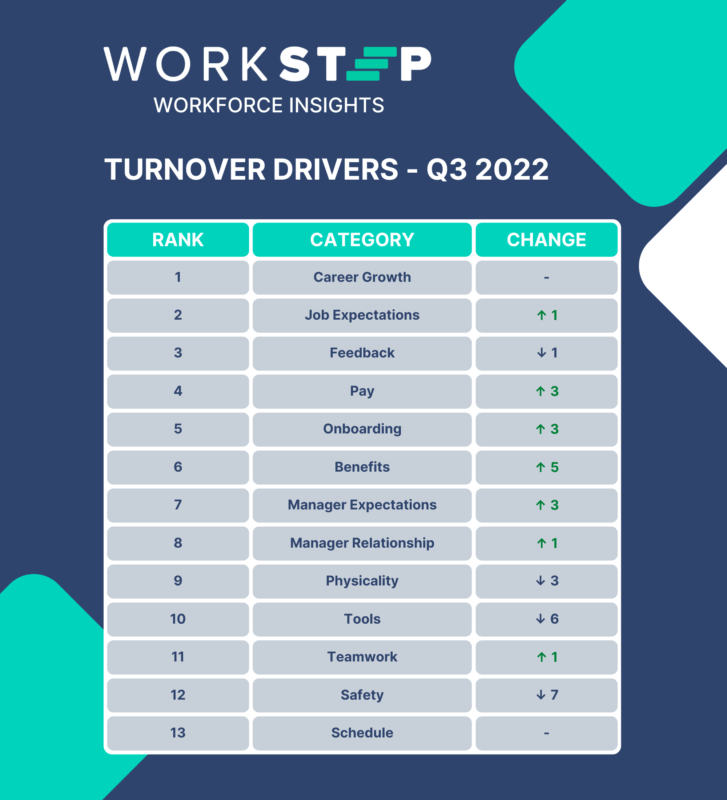Weekly Workforce Insights: WorkStep Q3 2022 Supply Chain Turnover Drivers — Career Growth Still #1
November 22, 2022
Frontline workers are speaking, and their voices are clear. Each quarter WorkStep reports on what’s driving hourly worker turnover by analyzing data from hundreds of companies and hundreds of thousands of employees — and the Q3 2022 results are in:

Onboarding jumped from #8 to #5 turnover driver
Looking back at our new hire turnover insights it’s readily evident that onboarding is a crucial part of workforce retention, especially during the first 30 days.
With the mass wave of post-pandemic hiring, it’s understandable that we’d see a marked increase from #8 to #5 in onboarding as a turnover driver due to a failure on the part of some companies to provide a robust and comprehensive onboarding experience. If employees feel they have not had an opportunity to internalize company culture and mission, or have not been able to establish ties with coworkers and managers, it’s natural that they might seek employment elsewhere.
Onboarding is much more than orientation and filling out forms — it’s an opportunity for organizations to set the foundation for manager-new hire relationships, set up mentorships with fellow employees, help workers get acclimated to the company culture and physical work environment, provide adequate training, and introduce career growth paths, which we expand upon below.
Pay continues to rise as a turnover driver
Pay jumped to #4 this quarter, up from #7 in Q2 and #10 in Q1, which aligns with current economic uncertainty, including record-breaking inflation, shaky market outlook, threat of recession, and increasing wages across the country.
We’ve said it before and we’ll say it again, while competitive pay is a concern for workers and an absolute necessity for hiring, it’s not the top hourly worker turnover driver, though clearly, the financial landscape is having an impact and companies would be wise to analyze their salary schedule to ensure they remain competitive.
Job expectations now #2 leading driver
Up slightly from #3 last quarter, job expectations rose to the #2 turnover driver. Workers expect clear, reasonable job expectations that are communicated to them from day one, or really even before hiring. If the job’s actual requirements don’t ultimately align with their understanding, or if expectations shift constantly, they are prone to find another job.
Encourage your hourly workforce management teams to be transparent about job requirements, set accommodating working conditions, and communicate proactively if a job might require crossover responsibilities.
Career growth remains #1
For the fifth quarter in a row, career growth remains the #1 supply chain turnover driver. Worker dissatisfaction is not necessarily a reflection of dissatisfaction with the company itself. Often, frontline employees simply believe their skills could be better applied in another role, or feel stagnated and are tired or complacent in their current role. Remember, your frontline workers prioritize career growth and advancement the same as all your other employees so it’s absolutely essential that you offer them clear career growth paths.
Be sure also that workers are aware of the opportunities that exist already. We are constantly reminded of situations in which workers are simply not aware of programs that are on offer within an organization. Checking in with your employees is just as important to inform and communicate existing benefits, procedure, and policies, as it is to solicit feedback.
How can you see what’s driving your turnover?
Every company is unique, and every employee has their own unique perspective, so let direct employee engagement be your guide. Feedback has remained in the top 3 list of turnover drivers throughout 2022 and it’s imperative that you engage and check in with your employees regularly and proactively. The only way to know what’s driving hourly worker turnover at your company is to check in with your employees. And the only way to mitigate that turnover is to take action on their feedback.
Tune into your frontline with WorkStep
With the frontline employee engagement platform that delivers the real-time insights you need to take action, retain your workforce, and drive your business forward.
Kristina Finn, Content Marketing Manager | kristina@workstep.com



